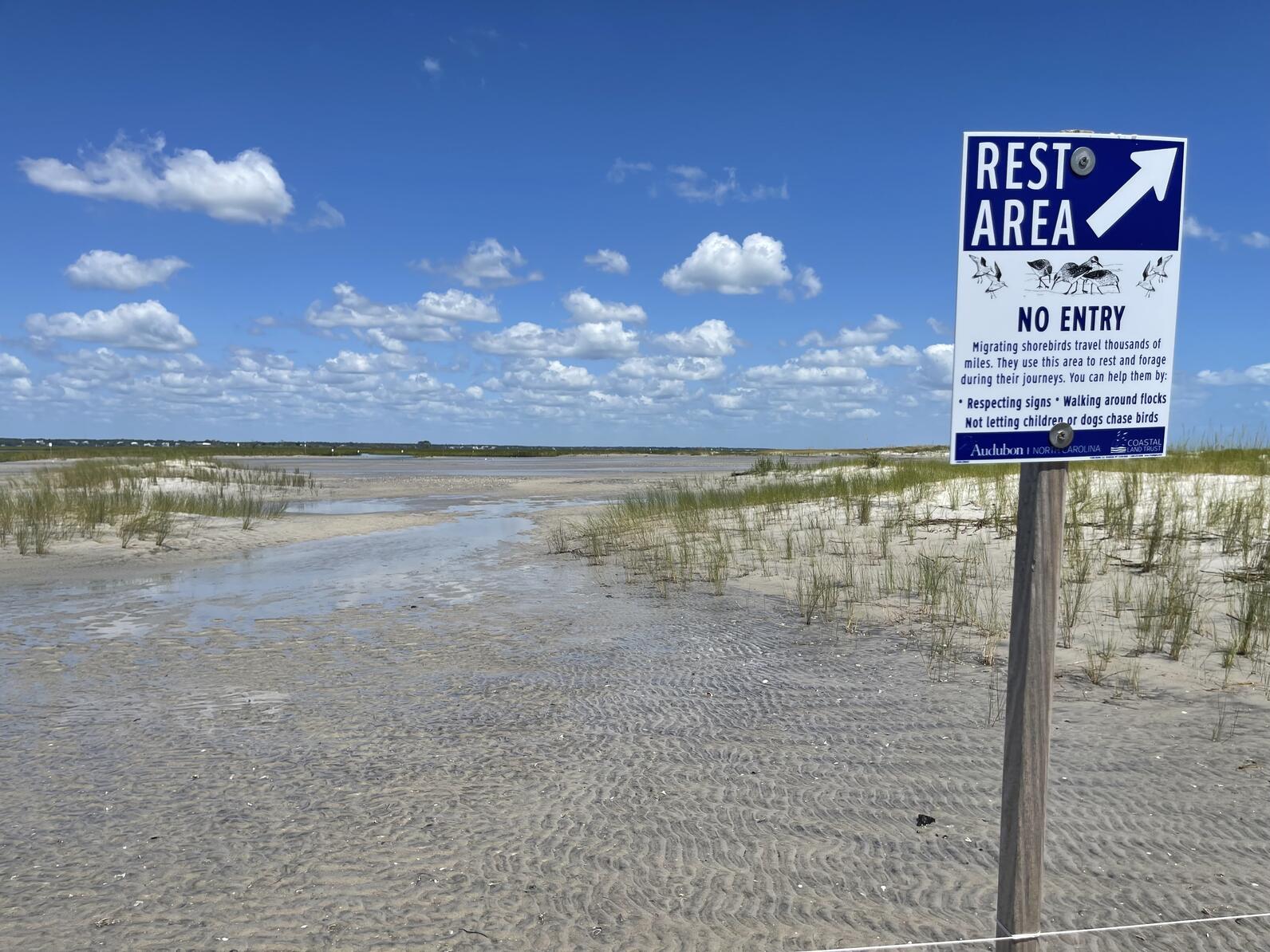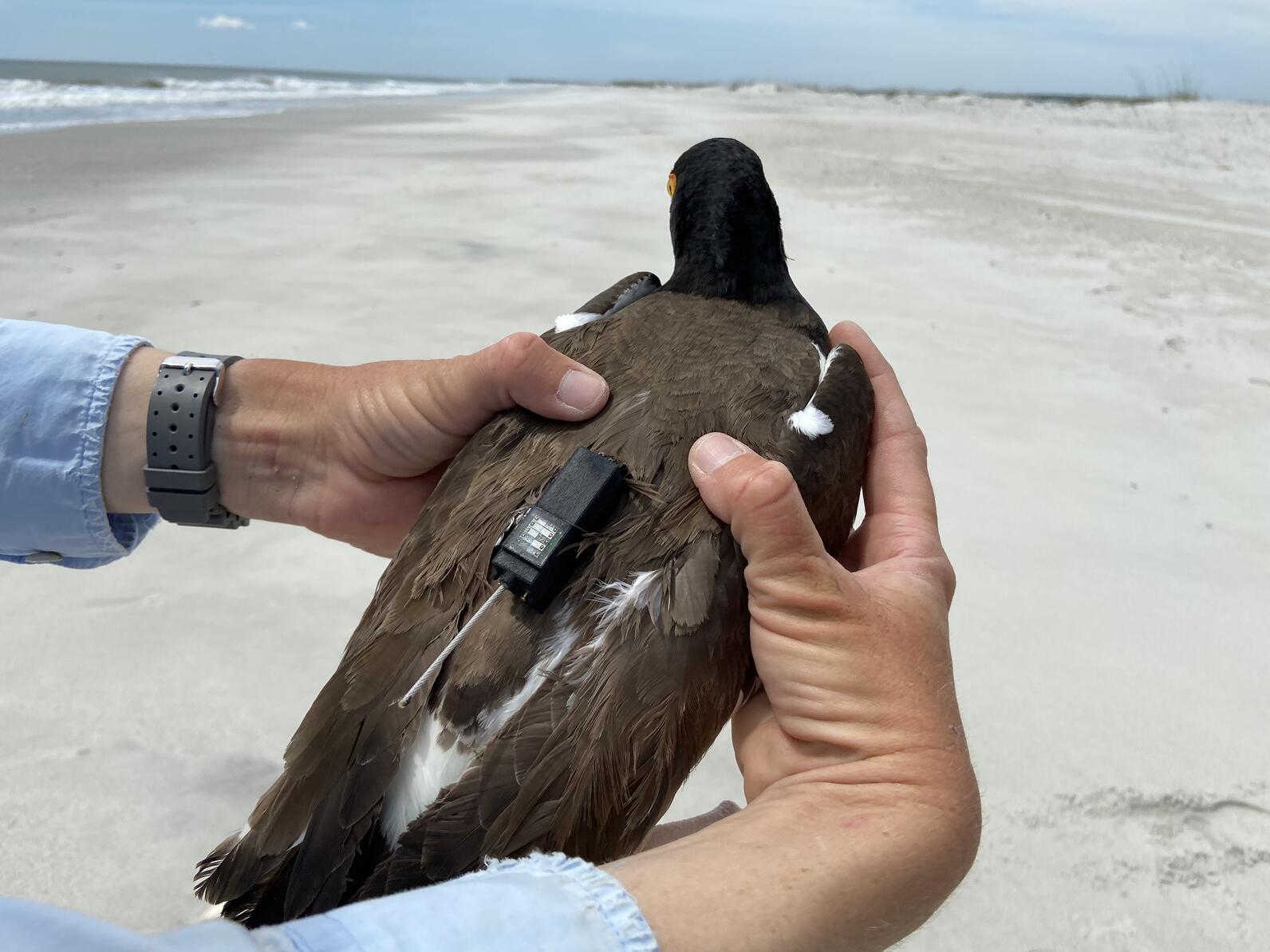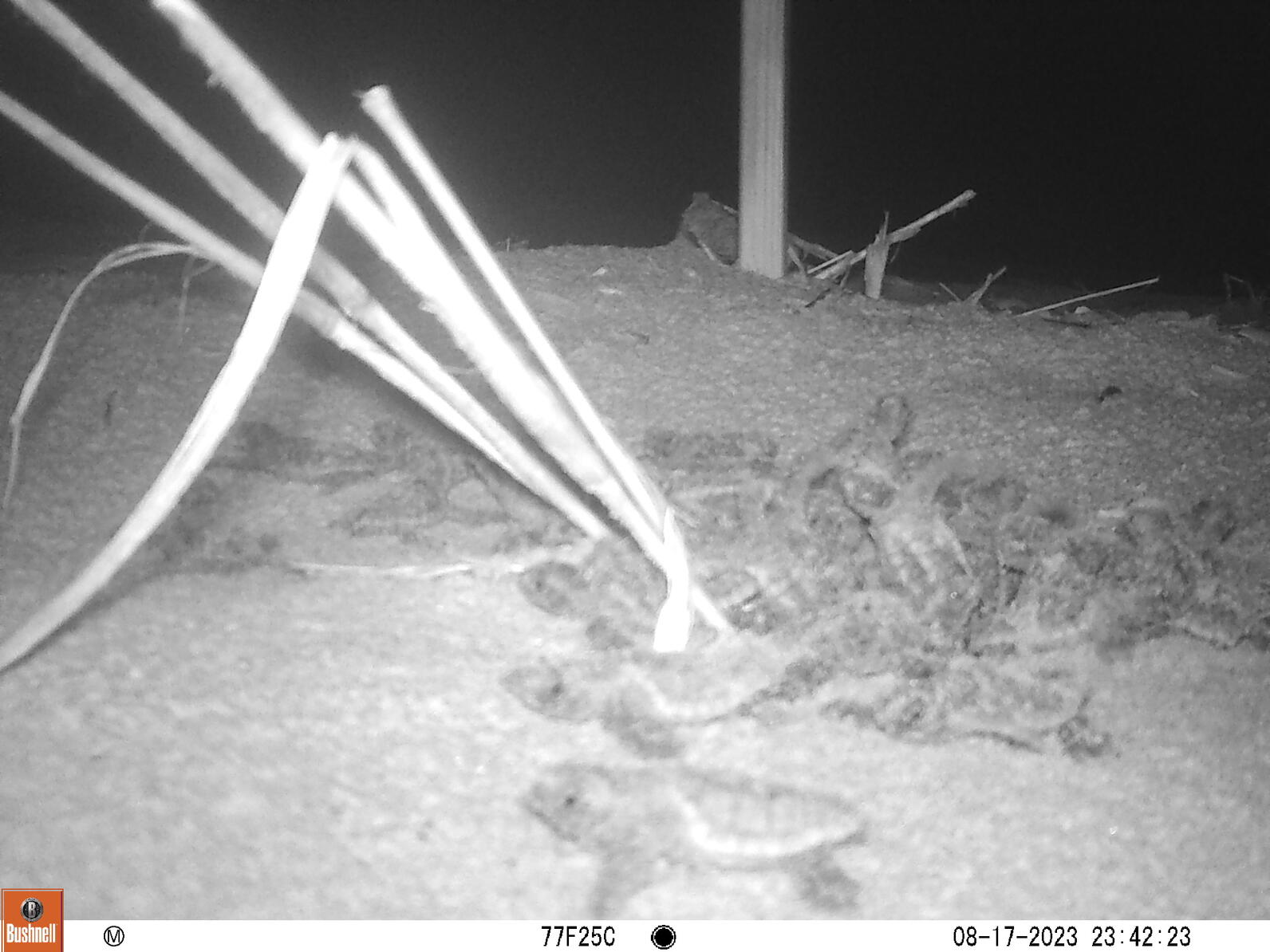This summer, we had thousands of successful fledglings at our coastal nesting sanctuaries. In addition to the hard work of managing these sites, our staff was busy launching new research projects and banding baby birds up and down the North Carolina coast.
The newly lengthened nesting sanctuary closure window—which now begins March 1 and ends Sept. 15, thanks in part to advocacy from Audubon members—gave these birds the time and space they needed to raise their young and adapt to pressures along the way, including early season losses due to storms, depredation, and disturbance.
Each year, Audubon’s sanctuaries provide safe breeding grounds for 40 percent of the state’s coastal nesting waterbirds. Our on-the-ground management, including help from volunteers like the Wrightsville Beach Bird Stewards, ensures that birds continue to have a safe place to raise their young.
As the season wraps up, it’s time to take a look back at how our coastal birds fared this summer.
Lea-Hutaff Island

At our Lea-Hutaff Island sanctuary, predation by coyotes was a challenge for many nesting species. But despite these setbacks, Least Terns, American Oystercatchers, and Wilson’s Plovers managed to raise their young.
Least Terns nested in nine different colonies on the island, with the majority located, as usual, at the north and south ends. We counted a total of 536 pairs, making the island one of the largest Least Tern sites in the state. Unfortunately, we estimate that fewer than a quarter of the pairs fledged chicks.
American Oystercatchers had a down year as well, with the 25 pairs (about 7% of the statewide breeding population) producing five fledglings. The 39 Wilson’s Plover pairs are not monitored as closely as the oystercatchers, but they appeared to do better later in the summer, with multiple pairs with large chicks in July and August. Meanwhile, Hutaff Island again hosted a small but successful colony of Green Herons that produced over 20 fledglings.
With nesting season wrapping up for these species, our coastal team visited the island earlier this month to put up new signs to protect migrating and wintering species. Migrating shorebirds travel thousands of miles and use the beaches and natural inlets for rest and forage. You can help them by respecting signs, walking around flocks, and not letting children or dogs chase birds.
South End of Wrightsville Beach

The Black Skimmer colony on the south end of Wrightsville beach was affected by a nor’easter that blew in over Memorial Day Weekend, when the first nests were incubating. Heavy rains impacted many nests, as did an unlikely predator—Ruddy Turnstones.
These industrious shorebirds peck and plow up sand and small shells or rocks to find prey, but they also peck open eggs. When bad weather or disturbance from beachgoers approaching too close to the posted area cause the skimmers to flush from their nests, the turnstones took advantage of the easy meal.
However, despite early losses, the skimmers remained and, along with a small colony of about 35 Least Tern pairs, they re-nested. Skimmers are able to nest late into the summer, and the hundred or so pairs that stuck it out were able to finsh the season strong. The last chicks were fledging from the site in mid-September, and the colony fledged around one chick per pair, which is an excellent success rate for beach-nesting species.
Skimmers were also able to find success in large numbers at Cape Lookout National Seashore where our coastal team worked with the National Park Service to band over 100 chicks, though Tropical Storm Idalia ended the season for pairs that still had eggs or unfledged chicks.
Cape Fear River
The Cape Fear River is one of North Carolina’s most important areas for nesting American Oystercatchers, hosting around 100 pairs across its marshes and dredge islands. Ferry Slip Island, which received dredged material two winters ago, continued to shine, as the 14 oystercatcher pairs there produced eight fledglings.

For those pairs that weren’t as successful, we began using trail cameras to try to detect cause of failure—which can be difficult to assess. Among the challenges the cameras captured were a ship wake washing eggs out of a nest (one of the parents was able to roll them back into place), a Laughing Gull flying off with an egg, and a Bald Eagle snacking on a chick just as it was hatching. The other pairs around the river didn’t do as well, with an estimated 10 fledglings between them.
In addition to the oystercatchers, the Cape Fear River is an important site for Royal and Sandwich Terns. South Pelican Island, located a couple miles upriver from Southport, was once again home to a successful colony. We counted 995 Sandwich Tern nests and 3,735 Royal Tern nests. With its diversity of habitats, from grassy marsh to open bare sand, the island also hosted a number of Brown Pelicans and 2,122 pairs of Laughing Gulls.
Finally, Battery Island is famous for its flocks of White Ibis, and it didn’t disappoint this year. Over 5,000 pairs nested there, along with nearly 1,300 pairs of Brown Pelicans and almost 900 pairs of herons and egrets.
Elsewhere Around the State
At Beacon Island, a marsh island situated in the middle of Ocracoke Inlet, continued to host a large Brown Pelican colony. The 494 pairs that nested there this season were hit hard by the Memorial Weekend storms, as many of the chicks were too big to fit under the parents but still too small to thermoregulate, and thus perished. However, renesting was successful and chicks from the first and second nesting attempts fledged along with chicks from about 40 pairs of Great Egrets.
Meanwhile, to the south, we also protect small slivers of nesting habitat for American Oystercatchers at Rich Inlet. Two of these four pairs fledged three total chicks. Our staff also continued to partner with Masonboro Reserve to help manage and monitor their nesting birds, and despite continued issues with coyote predation there, we were pleased to see some of the oystercatcher pairs succeed.
Oystercatcher Research Continues

This summer marked the third year of our American Oystercatcher datalogger project with Dr. Kate Goodenough, an Associate Researcher at the LSU AgCenter. Goodenough and Addison have been working to understand what factors help oystercatcher parents succeed by studying their foraging behavior and movement along the coast.
To do this, Goodenough and Addison harness GPS devices to the birds that collect data every 30 minutes. By getting a better look at their fine-scale movements, Goodenough can start to unravel how oystercatchers are using different habitats during the breeding season, how far they have to travel to forage, and what impact those factors have on the health of their chicks.
One interesting discovery they’ve made so far is that oystercatchers like to forage at night. “Their bi-parental care allows one adult to stay with the nest while the other forages for food as it is available during the day—or night—based on tidal cycles,” says Goodenough.
Over the course of the project, they’ve been able to collect data from 31 of 33 tagged adults during the breeding season. This summer, they recaptured seven birds that were tagged last year and attached GPS devices to another four oystercatchers.
By the end of this year, Goodenough hopes to be able to publish the results of this project and help on-the-ground biologists like Addison understand how best to manage important habitats for the American Oystercatcher.
Field-Readable Bands on Terns and Counting Colonial Waterbirds

In July dozens of volunteers flocked together to help our coastal team band thousands of Royal and Sandwich Terns. The chicks have since fledged, and we’re getting our first re-sightings as they depart the Cape Fear River. The first few reports came from the north. One was in Maryland and another visited Cape May County, New Jersey. These movements are part of a phenomenon called “reverse migration” where after nesting (or fledging), some individuals move north, perhaps in order to explore new potential nesting sites or productive foraging areas.
In North Carolina, we use black field-readable bands with white lettering and a unique number letter combination so these terns can be identified by anyone with binoculars or a scope while the bird is wild and free. If you come across a bird with a field-readable band, make sure to report it to the U.S. Geological Survey’s Bird Banding Lab or to lindsay.addison@audubon.org.
Also this summer, our team helped conduct the state's coast-wide waterbird census, visiting sites when the largest number of birds were nesting so they could estimate the total number of pairs of each species. Final numbers are still being tabulated for the state, and we look forward to getting the big picture of our Audubon-managed sites contribute to North Carolina’s total.
Sea Turtles on Lea-Hutaff Island
In addition to our bird work on Lea-Hutaff Island, Audubon staff monitors and protects nesting sea turtles as part of the North Carolina Wildlife Resources Commission’s sea turtle monitoring effort. This summer, we had 29 emergences, all by loggerhead sea turtles, and 14 nests. The last four nests to be laid were impacted by the passage of Tropical Storm Idalia, but the first 10 nests hatched successfully, with over 90% of the hatchlings making it out of the sand and into the ocean.
Biological Technician Anna Cheshire, who manages the island year-round was able to catch some of these baby turtles on camera.

As part of our partnership with the Wildlife Resources Commission, we collect one egg from each nest. The interior lining of the egg contains the unique DNA profile of the female that laid it, allowing researchers at the University of Georgia to identify each nesting female and estimate the total nesting population and track each nesting female’s movements and nests along the coast.
So far, three DNA profiles have been identified of the 14 samples collected this year. One of the turtles identified returned to the island for the first time in 11 years, which is a long gap for these turtles who normally nest every 2-3 years. She may have nested outside of the study area—Georgia, South Carolina, and North Carolina are all participating in the DNA study—or she may have just taken an extra-long break.
“It was really cool to see this female return after such a long time,” adds Cheshire. “It just goes to show how useful this information is to resource managers who want to ensure turtles have a place to nest even 10 years from now.”
All told, our sanctuaries provided critical habitat to thousands of coastal birds giving them the time and space they need to raise young. Even though nesting season is wrapping up, late-nesters like Black Skimmers and migrating birds like Red Knotts still need your help. Remember to respect posted nesting sanctuaries and enjoy these birds from a safe distance.
*Note that all banding, marking, and sampling is being conducted under a federally authorized Bird Banding Permit issued by the U.S. Geological Survey’s Bird Banding Lab. No visible light was used to obtain the sea turtle images, and all sea turtle conservation work is conducted under NCWRC permit 23ST06.











